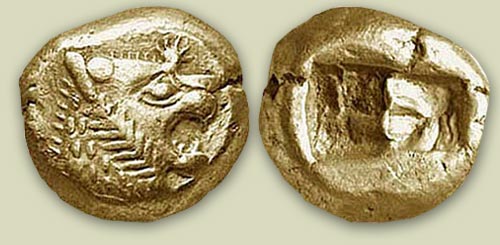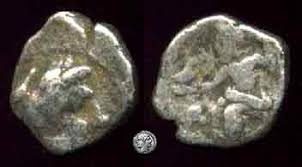It’s rare to find a modern coin that contains anything other than the following standard
decoration: an important civic symbol on one side, and a bust of a ruler
on the other. Actually, this traditional coin setup
began several thousand years ago in ancient Greece.
The first coins to be minted actually came from two places, where the idea of making small metal medallions that could be traded as currency seems to have developed simultaneously. At the end of the 7th century, both China and Lydia had begun to make plain, round coins for trade. The Greek historian Herodotus, in his work 'the Histories', briefly mentioned that the Lydians were minting coins around 600 BC. Either way, it wasn’t for another 150 years that coins became prominent around the Greek city-states.

Lydian coin - 600BC
Before the Greeks used minted coins, they made use of small iron rods for currency, called ‘obols’. Since around six obols could fit into the hand of an adult, six obols became equivalent of one drachma coin, once the system transferred over to coinage. In ancient Greek, the word drachma actually means “the graspable” – thus making it a logical choice of name.

Athenian silver obol

Athenian silver drachma
The island of Aegina was the first place in Greece to mint coins, made out of silver with a very basic geometric shape on either side. Around 500 BC, the Attic drachma had become widely used in the cities, but hadn’t yet spread to the outlying areas. These early Greek coins had Athena’s owl stamped on one side, the head of Athena on the other, and were made of almost pure silver.

'Aeginian turtle'-around 500BC
The Athenians produced huge quantities of coins during the Classical era, around 450 BC, in order to finance their enormous building projects on the Athenian acropolis. They also needed finances to pay for the Peloponnesian War, and it wasn’t long before Athens was demanding the required tribute payments from surrounding city-states in coinage.
Although the pictures on ancient Greek coins remained the same basically until the rise of Alexander the Great – when he would mint his own coins with his image on them – this means that the artistic history of the ancient Greeks can be traced with these coins, as artists’ techniques and tools developed over several centuries.
It was the standard unit of silver coinage at most ancient Greek and Roman mints, and the name 'obol' was used to describe a coin that was one-sixth of a drachma. The notion that "drachma" derived from the word for fistful was recorded by Herakleides of Pontos (387-312 BC) who was informed by the priests of Heraion that Pheidon, king of Argos, dedicated rod-shaped obeloi to Heraion. Similar information about Pheidon's obeloi was also recorded at the Parian Chronicle.
Ancient Greek coins seldom had official names. Each city would mint its own and have them stamped with recognizable symbols of the city, along with suitable inscriptions, and they would often be referred to either by the name of the city or of the image depicted (e.g. the Aeginetan "turtles"). The exact exchange value of each was determined by the quantity and quality of the metal, which reflected on the reputation of each mint.
The 5th century BC Athenian tetradrachm ("four drachma") coin was perhaps the most widely used coin in the Greek world prior to the time of Alexander the Great (along with the Corinthian stater). It featured the helmeted profile bust of Athena on the obverse (front) and an owl on the reverse (back).

Corithian stater-4th century BC
In daily use they were called γλαῦκες glaukes (owls),[6] hence the proverb Γλαῦκ’ Ἀθήναζε, 'an owl to Athens', referring to something that was in plentiful supply, like 'coals to Newcastle'. The reverse is featured on the national side of the modern Greek 1 euro coin.
Drachmas were minted on different weight standards at different Greek mints. The standard that came to be most commonly used was the Athenian or Attic one, which weighed a little over 4.3 grams.
After Alexander the Great's conquests, the name drachma was used in many of the Hellenistic kingdoms in the Middle East, including the Ptolemaic kingdom in Alexandria. The Arabic unit of currency known as dirham (in the Arabic language, درهم), known from pre-Islamic times and afterwards, inherited its name from the drachma or didrachm (δίδραχμον, 2 drachmae); the dirham is still the name of the official currencies of Morocco and the United Arab Emirates. The Armenian dram also derives its name from the drachma.
The first coins to be minted actually came from two places, where the idea of making small metal medallions that could be traded as currency seems to have developed simultaneously. At the end of the 7th century, both China and Lydia had begun to make plain, round coins for trade. The Greek historian Herodotus, in his work 'the Histories', briefly mentioned that the Lydians were minting coins around 600 BC. Either way, it wasn’t for another 150 years that coins became prominent around the Greek city-states.

Lydian coin - 600BC
Before the Greeks used minted coins, they made use of small iron rods for currency, called ‘obols’. Since around six obols could fit into the hand of an adult, six obols became equivalent of one drachma coin, once the system transferred over to coinage. In ancient Greek, the word drachma actually means “the graspable” – thus making it a logical choice of name.
Athenian silver obol

Athenian silver drachma
The island of Aegina was the first place in Greece to mint coins, made out of silver with a very basic geometric shape on either side. Around 500 BC, the Attic drachma had become widely used in the cities, but hadn’t yet spread to the outlying areas. These early Greek coins had Athena’s owl stamped on one side, the head of Athena on the other, and were made of almost pure silver.

'Aeginian turtle'-around 500BC
The Athenians produced huge quantities of coins during the Classical era, around 450 BC, in order to finance their enormous building projects on the Athenian acropolis. They also needed finances to pay for the Peloponnesian War, and it wasn’t long before Athens was demanding the required tribute payments from surrounding city-states in coinage.
Although the pictures on ancient Greek coins remained the same basically until the rise of Alexander the Great – when he would mint his own coins with his image on them – this means that the artistic history of the ancient Greeks can be traced with these coins, as artists’ techniques and tools developed over several centuries.
It was the standard unit of silver coinage at most ancient Greek and Roman mints, and the name 'obol' was used to describe a coin that was one-sixth of a drachma. The notion that "drachma" derived from the word for fistful was recorded by Herakleides of Pontos (387-312 BC) who was informed by the priests of Heraion that Pheidon, king of Argos, dedicated rod-shaped obeloi to Heraion. Similar information about Pheidon's obeloi was also recorded at the Parian Chronicle.
Ancient Greek coins seldom had official names. Each city would mint its own and have them stamped with recognizable symbols of the city, along with suitable inscriptions, and they would often be referred to either by the name of the city or of the image depicted (e.g. the Aeginetan "turtles"). The exact exchange value of each was determined by the quantity and quality of the metal, which reflected on the reputation of each mint.
The 5th century BC Athenian tetradrachm ("four drachma") coin was perhaps the most widely used coin in the Greek world prior to the time of Alexander the Great (along with the Corinthian stater). It featured the helmeted profile bust of Athena on the obverse (front) and an owl on the reverse (back).

Corithian stater-4th century BC
In daily use they were called γλαῦκες glaukes (owls),[6] hence the proverb Γλαῦκ’ Ἀθήναζε, 'an owl to Athens', referring to something that was in plentiful supply, like 'coals to Newcastle'. The reverse is featured on the national side of the modern Greek 1 euro coin.
Drachmas were minted on different weight standards at different Greek mints. The standard that came to be most commonly used was the Athenian or Attic one, which weighed a little over 4.3 grams.
After Alexander the Great's conquests, the name drachma was used in many of the Hellenistic kingdoms in the Middle East, including the Ptolemaic kingdom in Alexandria. The Arabic unit of currency known as dirham (in the Arabic language, درهم), known from pre-Islamic times and afterwards, inherited its name from the drachma or didrachm (δίδραχμον, 2 drachmae); the dirham is still the name of the official currencies of Morocco and the United Arab Emirates. The Armenian dram also derives its name from the drachma.
Since the value of proof coins rest on rarity and artistic value, they are more popular with hobby coin collectors.
ReplyDeleteThe recent state quarter proofing is a prime example of the difference, where the quarters are presented as collectible coins, even though there are many almost uncirculated, state quarter specimens available, and they have no silver coin value attached.
We can see more: coin collector case